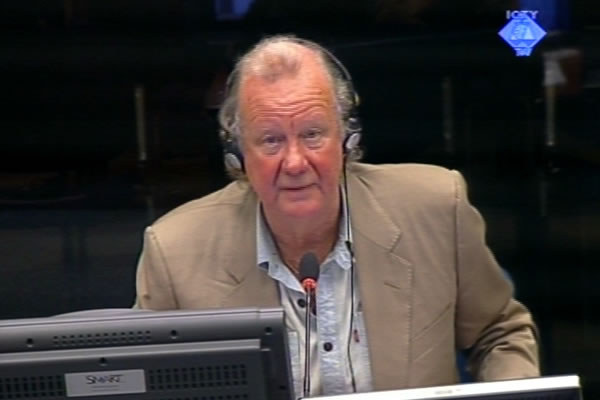Home
MLADIC’S DEFENSE: TRNOPOLJE WAS ‘HUMANITARIAN CENTER’
In the cross-examination of Ed Vulliamy the defense tried to prove that the prison camp in Trnopolje was a ‘humanitarian center’. As an ‘expert and insider’, the British journalist advised the OTP how to prosecute the accused Serbs. This made him an unreliable witness, the defense alleged
 Ed Vulliamy, witness at the Ratko Mladic trial
Ed Vulliamy, witness at the Ratko Mladic trial As Ratko Mladic’s defense counsel continued cross-examining British journalist Ed Vulliamy, he strove to show that the prison camp in Trnopolje was a ‘humanitarian center’, used to accommodate the people in transit who had fled the war zone. The defense corroborated this claim by showing the footage made by the Serb TV station from Pale, whose team joined Vulliamy and other British journalists in their visit to Omarska and Trnopolje on 5 August 1992.
In the recording from Trnopolje showed by the defense, a man was seen talking to Dragan Bozanic, a journalist from the SRNA agency. The man told Bozanic he sought shelter there because his village had been shelled. Another man explained that he had arrived there with his children directly from working their fields. Here, the man said, they could move around and nobody was abusing them. ‘This is Trnopolje, there were no fences here and people could move about freely’, defense counsel Dragan Ivetic put to the witness.
Vulliamy replied that Trnopolje was a ‘confusing place’: it consisted of a number of parts and the footage showed only the part where people could move freely and even leave the prison camp to forage for food. Answering the judges’ questions, the witness said that he had the impression that they could not go where they wanted because they would be in ‘deep trouble’.
The witness added that he saw another, enclosed part of the prison camp, housing the prisoners brought in from Keraterm and Omarska. They stood in front of a wall that was fenced on three sides. In August 1992, he didn’t visit every part of the prison camp. He realized that later, when he learned from the detainees that in some places they were abused and beaten, while women and girls were raped, Vulliamy explained.
In the re-examination, Vulliamy said that Trnopolje was a key place where the Serb forces gathered a large number of people whom they later deported. Only when he arrived in Travnik in a refugee convoy did Vulliamy realize the ‘scale and frequency’ of the deportations of the Muslims and Croats from the Serb-controlled territories.
The defense argued that when Radovan Karadzic invited Vulliamy and his colleagues to visit Omarska and Trnopolje, he gave them a list of prison camps and prisons where Muslim and Croat forces kept captured Serbs. Dretelj, Tarcin, Konjic and some other places were on the list. The witness confirmed that he had followed the trail and actually visited Dretelj in the second half of 1992 and later in 1993. Vulliamy met Mate Boban in Grude, a town he described as a ‘sinister place’ where photos of Ante Pavelic were displayed in shop windows. Vulliamy confirmed the defense counsel’s suggestion that one of the things Serbs feared was the ‘return of the Ustashas’.
The defense tried to depict Vulliamy as an unreliable witness, insisting on his contacts with the OTP. Defense counsel Ivetic put it to the witness that, as an ‘expert and insider’, Vulliamy advised the OTP how to prosecute Serbs and how to establish links between Radovan Karadzic, Nikola Koljevic, Momcilo Krajisnik and Biljana Plavsic with Major Milutinovic and Colonel Arsic, the military forces in Banja Luka and Prijedor, the Crisis Staff and police in Prijedor and the Omarska and Trnopolje prison camps.
Vulliamy confirmed that the OTP had contacted him several times about his possible testimony before the Tribunal, but that he was called to testify as an expert in the trials of Tadic and Blaskic, to testify about ‘the systematic and widespread character’ of crimes he had witnessed. Vulliamy was also called as a witness in the cases against Kovacevic, Sikirica, Stakic, Prlic and Karadzic. As Vulliamy explained, he had nothing to do with the trials of Momcilo Krajisnik and Biljana Plavsic.
The defense also tried to contest Vulliamy’s evidence about the incident that occurred when fire was opened on the convoy in which the British journalists left Prijedor for Omarska on 5 August 1992. As Vulliamy recounted, at one point, there was gunfire but he got the impression that the incident was staged to frighten the journalists and make them abandon their plan to visit the prison camp. Vulliamy concluded this because all the bullets flew over their heads and their Serb military escorts were running around and didn’t try to find cover.
In a bid to prove that the attack was real, the defense showed an excerpt from Judgment. The video contained a scene in which the convoy with the British journalists is stopped; Serb soldiers are running around while bursts from automatic guns and heavy explosions are heard in the background. In the re-examination, the prosecution proved that the footage had been edited: the prosecution played the original recording of the same incident with no sounds of gunfire and explosions. Only the sound of the engine of a stationary vehicle and people’s voices could be heard. The prosecution specified that the recording was obtained from the ‘Serbian TV Sarajevo network’ and was made by a team of Serbian journalists accompanying their British colleagues.
Linked Reports
- Case : Mladic
- 2012-09-19 'KARADZIC'S GUESTS' IN OMARSKA AND TRNOPOLJE
- 2012-09-06 WITNESS ACCUSES ARMY, DEFENSE BLAMES PARAMILITARIES
- 2012-09-06 PICKAXES, SHOVELS, BLOOD AND TEARS
- 2012-09-21 POLICE RAN PRISON CAMP, ARMY TOOK PEOPLE TO DO FORCED LABOR
- 2012-09-24 TESTIMONY OF INSIDER FROM MANJACA
- 2012-09-25 WHAT’S IN A ZERO?
